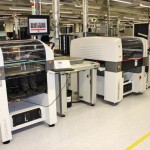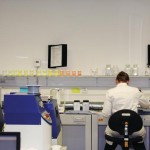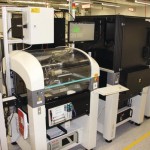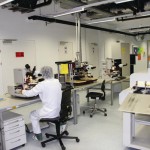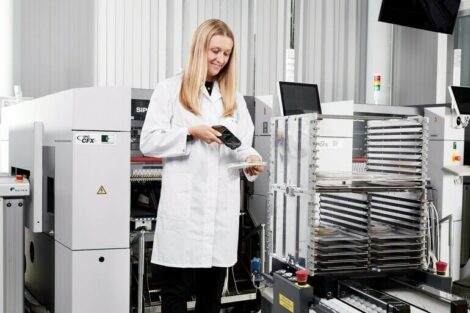In the industrial production of LED chips, it is not uncommon that deviations occur repeatedly within different production batches. The photometric characteristics, for example, may vary in color and luminosity. To ensure consistent light quality with a uniform light color and the same level of brightness, the LEDs within a batch must be sorted. This is one of the challenges that an LED manufacturer has to consider, among others. Tridonic in Jennersdorf, Austria solves this in an unconventional and innovative way, proving competence in this area.
Essemtec, Aesch (Switzerland) & Tridonic Jennersdorf GmbH, Jennersdorf (Austria)
Tridonic is an international technology leader in innovative lighting components, lighting management and LED systems, supplying products that result in intelligent and energy-efficient lighting solutions. Founded in 2001, the company understands its business in the operation, regulation and control of light, convincing with its LED and OLED portfolio through uncompromising quality. Its key to success, which is reflected in the history of the company, is based on close cooperation with the customer in conjunction with technical expertise. Sophisticated manufacturing technologies, know-how and reliability are the foundations of the success story.
Nothing remains undetected
To sort a batch of LEDs, binning is a common technique but it involves an elaborate process and an elevated level of scrap. Tridonic classifies the LEDs according to the American National Standards Institute (ANSI) standard. It defines color value deviations by means of MacAdam ellipses that describe the color differences on the XY coordinates. The specification of these ellipses tells the user how far, for example, the light color of individual LED modules differ from each other. In Jennersdorf, each customer order is not binned but produced directly in the ellipses and mostly using the chip-on-board (COB) process. As Robert Neuhold, Process Development Manager in the company, explains, the modules also have been manufactured in the SMD process for several months, with increasing tendency. The company has two SMD, eight COB and eight dispenser lines to meet the growing challenges in terms of LEDs. For what was still up to date yesterday may already be obsolete today, says Neuhold: “The lifecycle duration of LEDs is just two years and a progressive chip journey that always requires further development and innovative equipment. Thus, we notice a sharply rising trend in SMD modules with which we started about one year ago.” A big advantage of the company is evident in the production of color conversions that are developed using their own pastes. For this purpose, phosphorus is mixed with a silicone paste to generate a recipe, depending on the wavelength, that is then used directly in production. For a different type of phosphorus produces different color rendering values. This way, the company is able to accurately meet customers‘ demands and increase flexibility in all respects. In general, the module manufacturer specializes in general lighting in any form, delivering not only to its parent company as a member of the Zumtobel Group, but also to other manufacturers worldwide. In fact, they are intensifying their effort in finding new niches for new modules. Networking with other companies in the Group also turns out to be beneficial in order to ensure the mutual use of numerous patents. The patent situation was secured for all the company’s customers by cross-licensing agreements. The approximately 140 employees in research and development, production and logistics put all their energy into light in order to continue – in conjunction with innovative equipment – to be the market and technology leader in LED technology worldwide.
Manufacture of LED modules
To maintain competitiveness requires the necessary equipment in addition to a safe process. In this respect, there has been a close relationship since 2004 with Essemtec, the system manufacturer from Switzerland, with six measuring handlers and six reflow ovens from this manufacturer in production, in addition to a total of 16 dispensing systems. As the first customer for dispensing systems, Tridonic was able to do some pioneering work, contributing new ideas to develop the systems to customers‘ needs. The results are impressive, as systems have emerged from the former standard dispensers that are not only more robust and faster, but also demonstrate their quality in terms of accuracy.
After Essemtec replaced the CDS dispenser series in fall 2012 with the powerful Scorpion, which was created on the basis of the CDS Para platform specially developed for Tridonic, a decision had to be made in Jennersdorf. To maintain its leading position in the production of LED modules, the company always needs leading-edge, faster and even better equipment. In close cooperation between the two companies, three CDS systems were converted to the Scorpion platform, which promised an immense boost in speed. Since January 2014, the three converted dispensing systems have been working in production, and Neuhold reports: “By using the new dispensers we have become twice as fast in the jet process. While our previous throughput was around 36,000 dots/h, we are now at 60,000–65,000 dots/h, depending on the module type. The fast systems are a perfect match for our needs.”
Dispensing in duplicate
The Double Dispensing Equipment, as it is called in the company, is particularly well suited for applications where the same components must be placed in high numbers on the component carrier, as is the case with LED assembly. In this respect, the equipment is completely in the right place to perform its service.
The features used are listed below:
- Security level for creating users, assigning rights, as well as flexible definition of screen access
- Capturing of job numbers for creating jobs, including allocation of the medium with complete tracking of the status of all jobs in the archive
- Saving of dispensing points, i.e. the last dispensing position is saved and when restarting, the dispensing process can be continued from there, while individual positions also can be made manually
- Adjusting the production surface: the adjust factor can be changed during production
- Media data that is entered into the library can be assigned to a process; it is possible to create multiple settings for different needles or nozzles within the medium. Manufacturer, color of the medium, viscosity, particle or size can be entered
- An automatic log file of the input parameters of each PCB is not available, but all messages occurring or running jobs are recorded
- Multiple reference marks on the circuit board
- CAD data can be imported directly into the ePlace software without requiring any additional program
- Easy programming of circles and lines.
Neuhold also likes the software documentation. There is a detailed explanation for each menu item so that even a non-expert user can manage well. The six measuring handlers used are based on the dispensing systems and have been designed and manufactured specifically for the LED module manufacturer. They take an in-line measurement of the color locus. This ensures that dispensing always occurs in the right position with the right amount, resulting in consistent high quality. And although the current scrap rate is just around 3%, the Process Development Manager has set the goal of becoming even lower.
The companies‘ close and successful cooperation verifiably show success, providing either party with advantages so there are no barriers in the way of continuing the relationship. This is a profitable solution with innovation for both.
Zusammenfassung
Bei der industriellen Produktion von LED-Chips kommt es innerhalb unterschiedlicher Fertigungschargen immer wieder zu Abweichungen. Zur Vermeidung müssen LEDs einer Charge sortiert werden, nur eine der Herausforderungen in diesem Bereich. Mittels schnellem Dosiersystem speziell für die LED-Technologie gelingt einem Hersteller von LEDs eine präzise Farbwiedergabe ohne Binning.
Lors de la production industrielle de chips à LED, il y a toujours des divergences qui apparaissent au sein des différents lots de fabrication. Afin d’éviter cela, les LED d’un lot doivent être triés, un défi parmi d’autres dans ce domaine. Grâce à un système de dosage rapide spécialement conçu pour la technologie des LED, un fabricant de LED obtient une restitution précise des couleurs sans Binning.
Share:



